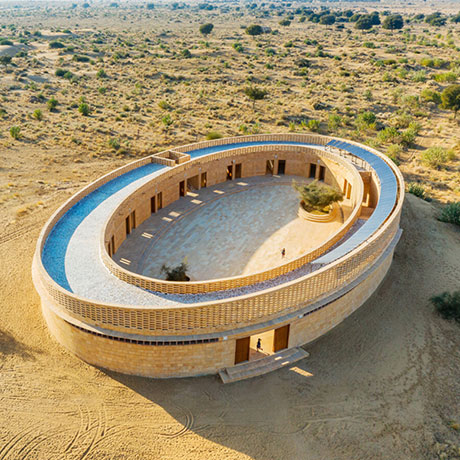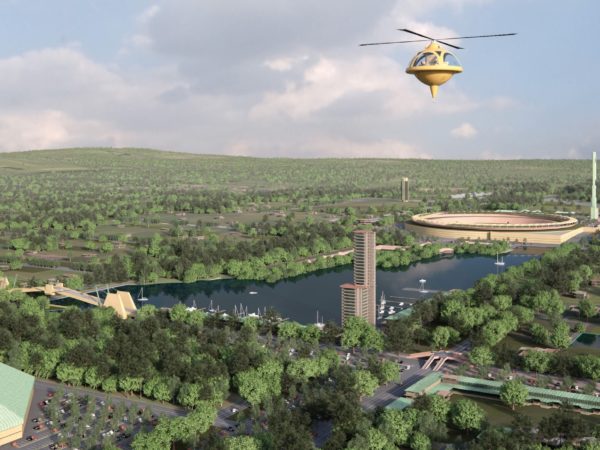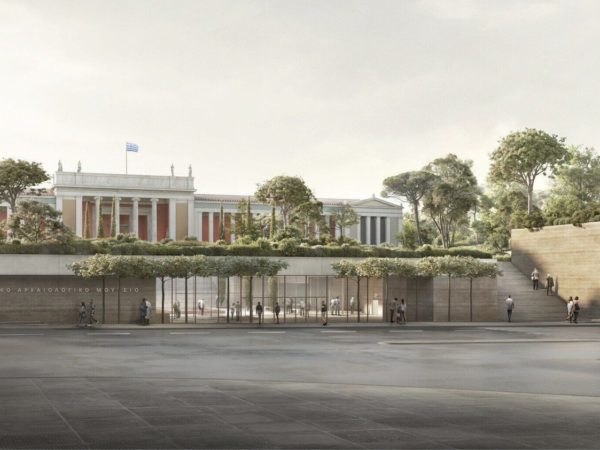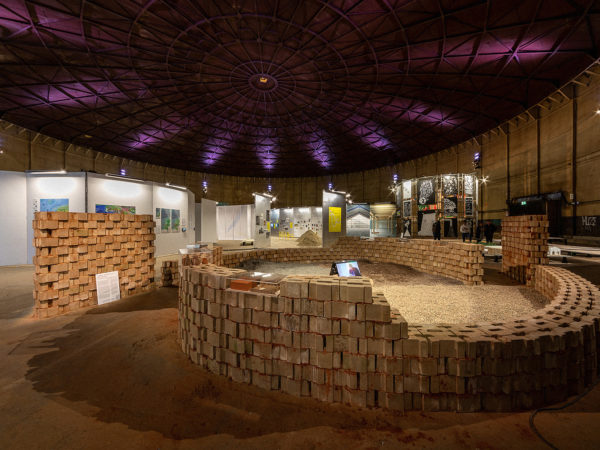While we have well established that contemporary architecture belongs to the 21st century, one can say that it is highly debatable amongst critics, as to what exactly defines the genre. Ranging from postmodernism and high-technology to sustainability and ontology, all are constituents of the same structure. Interim we are just healing from the dire situation of Covid-19, here are a few contemporary architecture projects that act as a ray of sunshine, providing hope for today and tomorrow. These five projects completed this year (2021) are reflective, invigorating and ingenious
Bee’ah is an environmental and waste management company based in UAE that had its reliance on Zaha Hadid Architects to design their expansive 7,000 sq. m. headquarters over 90,000 sq. m. land in Sharjah.
Situated in the middle of a desert, the curvaceously landscaped headquarter for Bee’ah draws inspiration from its surroundings. The structure strikingly, yet seamlessly, appears to emerge as fleeting ‘sand dunes’. Construction of the building is such that it minimises exposure to the jarring desert sun and harsh Shamal winds. A naturally ventilated and sunlit ‘oasis’ like courtyard connects the two sand dune structures. Bee’ah’s new HQ will act as a carrier in delivering further advancements in environmental services. It is fully powered by renewable energy and environmental design consultant Atelier Ten and engineer Buro Happold helped Hadid reach Bee’ah’s sustainable vision. Sustainability is a path to a hopeful future and it is inspiring to see invigorating architecture supporting the same. Started in 2014, followed by an international design competition, this environmentally conscious HQ is finally to be complete this year.
Speaking of awe-inspiring, contemporary architecture with a noble cause in 2021, Gyaan Center definitely tops the list. Built in Jaisalmer and designed by New York based architect Diana Kellog, this project is divided into three structures facilitating women and children.
First structure comprises Rajkumari Ratnavati Girl’s School that is complete and already functional. Second is a performance/ gallery/museum space called The Medha and third is The ‘Women’s Cooperative’; both are under construction. All three structures highlight a key Indian architectural element – ‘Courtyard.’ This project was initiated in 2018 by Michael Daube, founder of CITTA organisation and supported by Rooshad Shroff. CITTA believes in enhancing gender parity in the region. This project aims to empower women and children through education and various welfare programmes. The use of solar panels makes this project environmentally conscious. The empowerment through design begins with the structure of buildings that signify ‘ellipses’, which is a connotation for strength and divine feminine across cultures. Kellog finds a sense of comfort in the elliptical shape which she hopes would heal and nurture children. She also believes her career found a new meaning and purpose with this project and her community experiences in India.
Junya Ishigami is a globally renowned architect with several awards under his hat; OBEL, Golden Lion and BSI Swiss Architectural Award to name a few. Ishigami believes in breaking away from the conventional norms of architecture and he is renowned for his ingenuity that is evident in his recent work for Kanagawa Institute of Technology. The plaza is a rectangular structure with 59 rectangular openings, spread across all five sides that make way for natural light and ventilation. This is the architect’s second project with the Kanagawa Institute of Technology, first being an award winning KAIT Workshopthat features a completely transparent structure. The plaza is an aid for the students to unwind, relax and recharge. It acts as a mediator between architecture and nature, allowing natural weather conditions like wind, direct sunlight, rain to seep through the building that normal architectural spaces forbid. The curved nature of the Plaza floor, free of any structural support, plays the horizon to the landscape. Floor is also layered with asphalt that helps keep the floor dry during heavy rains.
Inspired by nature, this library in South China is futuristic and visually stimulating. Designed by MAD Design Studio this overlooks the South China Sea in the city of Haikou. MA Yansong founded MAD design studio in 2004 in Beijing. Imitating a ‘wormhole’, this structure definitely challenges the conventionality of traditional public spaces. There are two parts in this space; one is the library with an expansivereading room and other forpublic facilities. The building is seamlessly curvaceous in nature and comprises a terraceoverlooking the sea. To achieve this, the designers have used 3D printers and CNC cutting machines. The holes in the wormhole provide a passage for natural light and windows allow pleasant sea-breeze to enter the space. MAD believes in maintaining theminimalist look on the interiors as well, so consequently, all the wiring and pipelines are veiled under concrete. As designers are putting up a challenge to re-define public spaces, this is the first of few structures to be constructed on Haikou Bay.
Schmidt Hammer Larsen Architects and Gottlieb Paludan Architects completed this massive project in a conjoined effort. This colossal and futuristic waste to energy plant is reflective of modern day architecture and China’s efforts to minimise environmental degradation. Situated in the mountainous region of Shenzhen this facility aims to convert upto 5,000 tonnes waste per day. A major chunk of this building’s rooftop, 45,000 sq. m. has photovoltaic panels installed that will help in energy generation. The plant aims to lead by example and educate the population and businesses to reduce and manage waste. The form of the structure is circular in nature and aids in controlling the footprint and excavation required for construction. This one of a kind waste to energy plants not only inspires Chinese citizens but the world, to take conscious and sustainable measures.
Text by Shalini Passi
Image Courtesy: Bee’ah HQ, CITTA India, Junya Ishigami + Architects, MAD Design Studio and Schmidt Hammer Lassen Architects
Find more about the Designs and Architects:
https://beeah.ae/en/the-future
https://www.zaha-hadid.com/architecture/beeah-headquarters-sharjah-uae/
https://www.cittaindia.org/gyaan-center.aspx
https://citta.org/gyaancenter/










